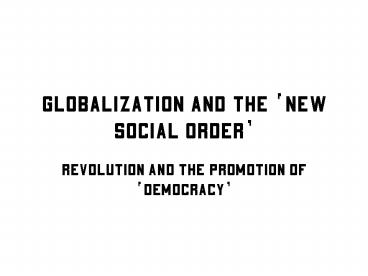Globalization and the New Social Order PowerPoint PPT Presentation
1 / 45
Title: Globalization and the New Social Order
1
Globalization and the New Social Order
- Revolution and the promotion of Democracy
2
Guatemala 1944-1954
- Stopped by a U.S. lead coup
- Population coerced into living under a wave of
despotic regimes
3
Nicaragua 1979--
- Internal forces mistakes, arrogance,
inexperience, etc - External forces low-intensity war surrogate
army, destroying symbols of the revolution
4
U.S. foreign policy authoritarian regimes and
democratic regimes
5
Globalization, the world system, and democracy
promotion in U.S. foreign policy (Robinson,
1996)
- within a process of transnationalism in the age
of the global economy. - coercive domination to consensual model of
social control - Massive expansion of international capital under
U.S leadership - achieving order and security for U.S global
interests
6
Why?
- Under new conditions of global capitalism a new
type of social order develops - Authoritarian regimes are obstacles economic and
information flows - Generates new pressures and new actors for
political change
7
(No Transcript)
8
institutional constrains on effective opposition
to the social order
9
From authoritarianism to the active promotion of
democracy
- 1980s and 90s creation of new apparatus for
implementing democracy - Polyarchyrefers to a system in which a small
group actually rules and mass participation in
decision-making is confined to leadership choice
in elections carefully managed by competing
elites.
10
(No Transcript)
11
Gramscian Hegemony
- Coercive domination and consensual domination
- Hegemony as a social relation binds together a
block of diverse classes and groups under
circumstances of consensual domination (628).
12
Hegemony is not simply something that happens as
a mere superstuctural derivative of economic
structures. ...it happens through a multiplicity
of superstructural agencies and instances
13
post-modern global culture and global
consumption pattern Culture-ideology of
consumerism
14
In short, by redefining the economic terms of
North-South relations, globalization also
redefined the political terms of these relations
(622)
15
How is the Sandinista regime (its accomplishments
and legacy) an obstacle to global capitalism?
16
(No Transcript)
17
(No Transcript)
18
(No Transcript)
19
http//marcus.whitman.edu/bloomqcm/
20
This is another way of restoring the values of
the past with vengeance. (Ramirez Mercado in
Adios Muchachos 1999 44)
21
(No Transcript)
22
(No Transcript)
23
(No Transcript)
24
Latin America is a slave economy masquerading as
post-modern it pays African wages, it charges
European prices, and the merchandise it produces
most efficiently is injustice and violence
(Galeano 1998 29).
25
Creating the conditions for major changes
- Elimination of revolutionary gains as obstacles
for industrial development - Paving the way for profound changes
- This changes had a lot to do with global politics
of neoliberalism structural adjustment
26
Structural adjustment
- Structural Adjustment Policies are economic
policies which countries must follow in order to
qualify for new World Bank and International
Monetary Fund (IMF) loans and help them make
debt repayments on the older debts owed to
commercial banks, governments and the World
Bank.
27
SAPs generally require countries to devalue their
currencies against the dollar lift import and
export restrictions balance their budgets and
not overspend and remove price controls and
state subsidies.
28
SAPs are aimed at
- To restore economic stability through
privatization, - Restructuring of the banking system credit
restriction - Restructuring of government institutions
29
What does it mean for people?
- Higher prices for basic necessities electricity
and water - Relaxation of labour codes less control, less
reinforcement - Deterioration of families, human rights, etc
30
Latin America is a slave economy masquerading as
post-modern it pays African wages, it charges
European prices, and the merchandise it produces
most efficiently is injustice and violence
(Galeano 1998 29).
31
Revolutionary gains
- Agrarian reform
- --land distribution
- --accessibility to credit
- --education
32
Workers rights
- Bargaining power strengthen
- Labor laws
- More workers organized
33
Womens rights
- Legal framework
- Practical terms maternity leave
- Education
- Creation of organizations
34
Establishment of democratic institutions
- Creation of CSE
- Creation of national assembly
- First elections 1984
35
Healthcare
- Universal medicare
- Health brigades,
- Health education
- Rural access
36
Healthcare
- Universal medicare
- Health brigades,
- Health education
- Rural access
37
Education
- Public education
- Literacy campaign
- Continuing education
- 6 for universities
38
National identity
- Sense of independence
- Sense of possibilities
- Control of destiny
- Flexibility in diplomatic relations
39
Impact of reversal of Sandinistas gains
- Government control lifted
- Abundance of food but no one can afford it
- From collective solidarity to ruthless
individualism
40
Reasons behind structural adjustments
- . USA interest in eliminating government
obstacles to trade - 2. -Promote reforms to political and military
institutions to their liking - 3. Encourage Central American economic and
political integration under North American
Dominance
41
Economic consequences
- Agrarian reform dismantled
- Education major changes
- Health care privatize
- Womens rights under threat
- National identity becomes under the influence of
USA policies - Labor issues situation as bad as in Somozas time
42
- Why put so much effort into erasing traces of the
revolution and on transforming the urban
landscape? Why spend so much money in erecting
gleaming monuments after so many deaths?
43
Reasons
- The images, and symbols of the revolution
contrary to the ideals of rampant capitalism - Sandinistas still a threat to the new social
order - A new physical and ideological landscape needed
to be constructed.
44
PPP
- Plan Puebla Panama
- 64 million people
- Eight countries
- Infrastructure, development and jobs
- Maquila assembly factories
45
(No Transcript)

